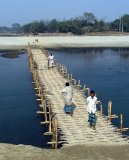| Introduction - Bangladesh: |
| Location - Bangladesh: |
| People - Bangladesh: |
| Government - Bangladesh: |
| Economy - Bangladesh: |
Economy overview | Despite sustained domestic and international efforts to improve economic and demographic prospects, Bangladesh remains a poor, overpopulated, and inefficiently-governed nation. Although more than half of GDP is generated through the service sector, nearly two-thirds of Bangladeshis are employed in the agriculture sector, with rice as the single-most-important product. Major impediments to growth include frequent cyclones and floods, inefficient state-owned enterprises, inadequate port facilities, a rapidly growing labor force that cannot be absorbed by agriculture, delays in exploiting energy resources (natural gas), insufficient power supplies, and slow implementation of economic reforms. Reform is stalled in many instances by political infighting and corruption at all levels of government. Opposition from the bureaucracy, public sector unions, and other vested interest groups also have blocked progress. The BNP government, led by Prime Minister Khaleda ZIA, has the parliamentary strength to push through needed reforms, but the partys political will to do so has been lacking in key areas. On an encouraging note, growth has been a steady 5-6% for the past several years. |
|
Gdp purchasing power parity | $336.7 billion (2006 est.) |
|
Gdp official exchange rate | $69.34 billion (2006 est.) |
|
Gdp real growth rate | 6.6% (2006 est.) |
|
Gdp per capita ppp | $2,300 (2006 est.) |
|
Gdp composition by sector | agriculture: 19.9%
industry: 20.6%
services: 59.5% (2006 est.) |
|
Labor force | 68 million
note: extensive export of labor to Saudi Arabia, Kuwait, UAE, Oman, Qatar, and Malaysia; workers remittances estimated at $4.8 billion in 2005-06. (2006 est.) |
|
Labor force by occupation | agriculture: 63%
industry: 11%
services: 26% (FY95/96) |
|
Unemployment rate | 2.5% (includes underemployment) (2006 est.) |
|
Population below poverty line | 45% (2004 est.) |
|
Household income or consumption by percentage share | lowest 10%: 3.9%
highest 10%: 28.6% (1995-96 est.) |
|
Distribution of family income gini index | 31.8 (2000) |
|
Inflation rate consumer prices | 7.2% (2006 est.) |
|
Investment gross fixed | 24.9% of GDP (2006 est.) |
|
Budget | revenues: $6.389 billion
expenditures: $8.694 billion; including capital expenditures of $NA (2006 est.) |
|
Public debt | 46.7% of GDP (2006 est.) |
|
Agriculture products | rice, jute, tea, wheat, sugarcane, potatoes, tobacco, pulses, oilseeds, spices, fruit; beef, milk, poultry |
|
Industries | cotton textiles, jute, garments, tea processing, paper newsprint, cement, chemical fertilizer, light engineering, sugar |
|
Industrial production growth rate | 7.2% (2006 est.) |
|
Electricity production | 18.09 billion kWh (2004) |
|
Electricity consumption | 16.82 billion kWh (2004) |
|
Electricity exports | 0 kWh (2004) |
|
Electricity imports | 0 kWh (2004) |
|
Oil production | 6,813 bbl/day (2004) |
|
Oil consumption | 85,000 bbl/day (2004 est.) |
|
Oil exports | NA bbl/day |
|
Oil imports | NA bbl/day |
|
Oil proved reserves | 56 million bbl (1 January 2005) |
|
Natural gas production | 13.1 billion cu m (2004 est.) |
|
Natural gas consumption | 13.1 billion cu m (2004 est.) |
|
Natural gas exports | 0 cu m (2004 est.) |
|
Natural gas imports | 0 cu m (2004 est.) |
|
Natural gas proved reserves | 300.2 billion cu m (1 January 2005 est.) |
|
Current account balance | $339 million (2006 est.) |
|
Exports | $11.17 billion (2006 est.) |
|
Exports commodities | garments, jute and jute goods, leather, frozen fish and seafood (2001) |
|
Exports partners | US 25.2%, Germany 12.7%, UK 9.9%, France 5% (2006) |
|
Imports | $13.77 billion (2006 est.) |
|
Imports commodities | machinery and equipment, chemicals, iron and steel, textiles, foodstuffs, petroleum products, cement |
|
Imports partners | China 18%, India 12.7%, Kuwait 8%, Singapore 5.6%, Hong Kong 4.2% (2006) |
|
Reserves of foreign exchange and gold | $3.278 billion (2006 est.) |
|
Debt external | $22.55 billion (2006 est.) |
|
Economic aid recipient | $1.575 billion (2000 est.) |
|
Currency code | taka (BDT) |
|
Exchange rates | taka per US dollar - 69.031 (2006), 64.328 (2005), 59.513 (2004), 58.15 (2003), 57.888 (2002) |
|
| Communications - Bangladesh: |
| Transportation - Bangladesh: |
| Military - Bangladesh: |
This page was last updated on 16 September, 2007



